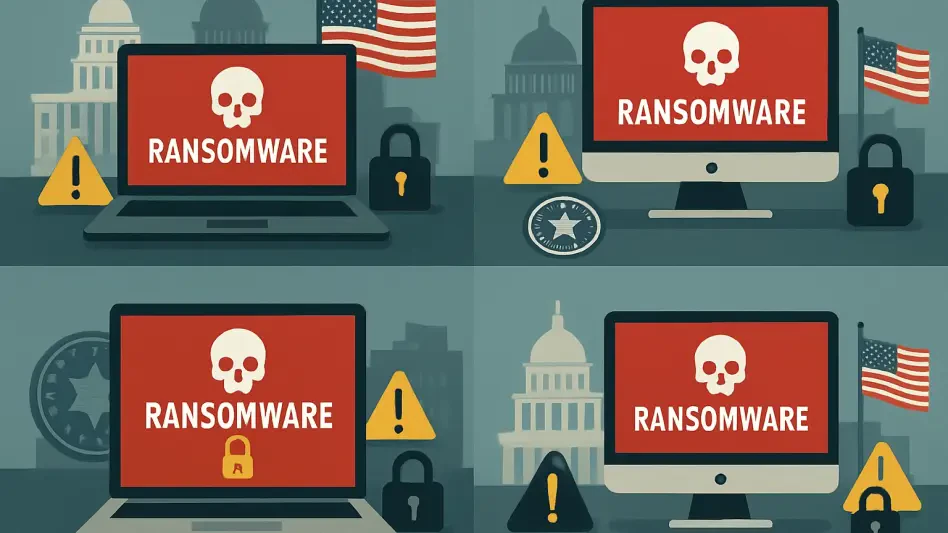Imagine a small municipal office grinding to a halt, unable to process citizen requests or access critical data, all because a ransomware attack has locked their systems, creating chaos and uncertainty. This scenario is becoming alarmingly common for government agencies worldwide, with a reported 65% surge in such incidents, totaling 208 cases in the first half of this year alone. As public institutions grapple with disrupted services and compromised data, the urgency to understand and combat this escalating cyber threat has never been greater. This roundup brings together diverse perspectives from cybersecurity professionals, policy analysts, and industry reports to explore why government entities are increasingly targeted, what trends are shaping these attacks, and how to fortify defenses against an adaptive enemy.
Unveiling the Spike in Government Ransomware Attacks
Visibility and Vulnerability in the Public Eye
One recurring theme among cybersecurity experts is the high visibility of government agencies as a magnet for ransomware actors. Unlike the private sector, where breaches might stay under wraps, public entities often confirm attacks at a rate of 50%, far exceeding other industries like healthcare or education. This transparency, while necessary for accountability, can inadvertently fuel attacker interest by amplifying their impact through media exposure.
Analysts point out that the public nature of these institutions makes them symbolic targets. A successful breach against a government body often garners widespread attention, enhancing the notoriety of ransomware groups. This dynamic creates a vicious cycle where visibility breeds more attacks, as cybercriminals seek both financial gain and reputational clout.
There is, however, a split in opinion on how transparency should be managed. Some professionals advocate for measured disclosure to maintain public trust, while others warn that excessive openness might embolden attackers further. Striking a balance between informing citizens and minimizing strategic advantages for criminals remains a debated challenge in policy circles.
Geographic Patterns and Structural Weaknesses
Geographic disparities in ransomware incidents reveal another layer of concern, with the United States accounting for 35% of global attacks on government bodies. Experts highlight that local governments, particularly in smaller municipalities, often lack the budgets for robust cybersecurity, making them easy prey compared to federal agencies with greater resources.
Beyond the U.S., countries like Brazil and Canada also face significant threats, with notable cases such as a $2.1 million ransom demand on a Spanish city illustrating the global reach of this issue. Industry observers note that decentralized governance structures in many regions exacerbate vulnerabilities, as fragmented systems are harder to secure uniformly against sophisticated threats.
A common critique among specialists is the chronic underfunding of digital defenses in smaller jurisdictions. Many argue that without targeted investments and centralized support, these areas will continue to serve as entry points for broader attacks, potentially disrupting national-level operations. The consensus leans toward prioritizing resource allocation to address these structural gaps.
Sophisticated Tactics of Cybercriminal Groups
Ransomware gangs have evolved their strategies to specifically target government entities, according to security researchers. Groups like Qilin and INC employ tailored approaches, often stealing massive datasets—sometimes terabytes worth—to maximize leverage. Such tactics aim to pressure victims into compliance through the threat of data leaks if ransoms go unpaid.
Another emerging trend flagged by experts is the shift to alternative revenue models when payments are refused. With many governments adhering to no-ransom policies, attackers increasingly auction stolen data on the dark web, ensuring profitability regardless of direct payment. This adaptability underscores the resilience of these criminal networks in the face of policy resistance.
Differing views exist on the effectiveness of non-payment stances. While some cybersecurity professionals believe such policies could eventually deter attacks by reducing financial incentives, others contend that the pivot to data sales nullifies this impact. The debate highlights the need for strategies that address both immediate threats and long-term criminal behavior.
Why Governments Face Higher Attack Growth
Compared to other sectors, government agencies have seen a disproportionate rise in ransomware incidents, with a 65% increase contrasting sharply against healthcare’s modest 4% uptick. Industry analysts attribute this to the critical role of public institutions, whose disruption causes widespread societal impact, making them attractive targets for maximum chaos.
When juxtaposed with industries like technology or retail, which also face significant threats, governments stand out due to their symbolic value. Experts suggest that attackers view breaches of public systems as a way to undermine trust in governance, a motive less prevalent in attacks on private entities where financial gain often dominates.
Speculation among professionals centers on whether ransomware groups will deepen their focus on specific sectors like government over time. Some predict a continued imbalance unless public sector defenses catch up, while others warn of potential spillovers to adjacent critical industries if current trends persist unchecked.
Key Takeaways from Diverse Cybersecurity Voices
Insights from various cybersecurity stakeholders emphasize the alarming escalation of ransomware threats to public institutions. A consistent observation is that high visibility, while essential for transparency, often backfires by drawing more attackers. Additionally, geographic and structural weaknesses, especially in under-resourced areas, remain a critical point of failure that demands urgent attention.
Practical recommendations emerge from these discussions, including the need for increased cybersecurity funding to protect vulnerable local governments. Experts also stress the importance of comprehensive training programs for staff to recognize and mitigate threats early. Furthermore, fostering international collaboration to track and dismantle ransomware networks is seen as a vital step in curbing global attacks.
A nuanced perspective among policy advisors focuses on managing disclosure practices. Balancing the public’s right to know with the risk of encouraging further incidents is a tightrope walk, but many agree that standardized guidelines could help. This approach, combined with proactive defense investments, offers a pathway to reduce both the frequency and impact of these disruptive cyberattacks.
Charting the Future of Government Cyber Defense
Looking back, the discussions and analyses from this year painted a stark picture of ransomware as a persistent menace to government operations. The 65% surge in attacks served as a wake-up call, revealing deep-seated vulnerabilities and the cunning adaptability of cybercriminal groups. Diverse expert opinions underscored the complexity of tackling this issue through policy, funding, and international efforts.
Moving forward, actionable steps should include establishing dedicated cyber defense funds for smaller municipalities to bridge resource gaps. Governments might also consider creating shared intelligence platforms to anticipate and counter evolving tactics of ransomware gangs. Exploring innovative technologies, such as advanced threat detection systems, could provide an edge against increasingly sophisticated adversaries. These measures, if prioritized, offer hope for stronger resilience in the face of an unrelenting digital threat landscape.








